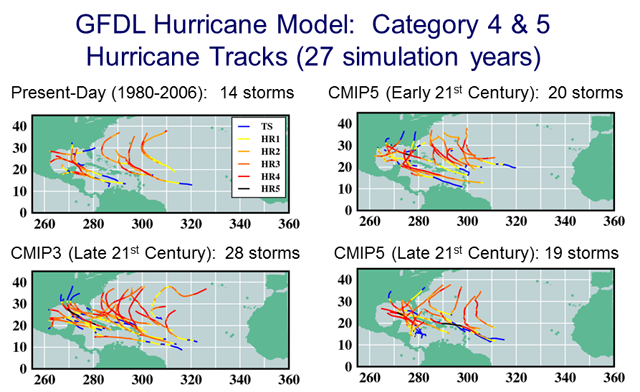June 24th, 2013
Key Findings
- A reduction in Atlantic tropical storm frequency (about -25%) with projected 21st century climate warming remains robust.
- Tropical cyclone-related rainfall rates increase, with significant increases of about 30% in the hurricane inner core (within 50 km of the storm center) with a smaller increase of about 10% averaged within 200 km to 400 km of the storm center.
- Relative sea surface temperature changes continue to be a good predictor of dynamical downscaling model behavior for Atlantic tropical storm frequency, based on a large sample of dynamical modeling results.
- The simulated increase in category 4-5 hurricanes, a prominent finding of Bender et al. (2008) is not as robust for the CMIP5 ensemble climate change experiments. For CMIP3 late 21st century, the increase was +87% and significant; for CMIP5 early 21st century the increase is +45% and marginally significant; for CMIP5 late 21stcentury the increase is +39% and marginally significant.
Thomas R. Knutson, Joseph J. Sirutis, Gabriel A. Vecchi, Steven Garner, Ming Zhao, Hyeong-Seog Kim, Morris Bender, Robert E. Tuleya, Isaac M. Held, and Gabriele Villarini. Journal: Journal of Climate. DOI: 10.1175/JCLI-D-12-00539.1
Summary
The authors explored the influence of anthropogenic climate change on Atlantic hurricane activity in the 21stcentury, using dynamical climate models. The results of experiments using multi-model climate change scenarios were compared, with one scenario taken from CMIP3 (A1B), and one from CMIP5 (RCP4.5). A significant reduction in the frequency of tropical storms and hurricanes is projected for both CMIP3 and CMIP5 ensembles. However, the authors found significantly increased frequency of category 4 and 5 hurricanes in experiments with the CMIP3 ensemble. Experiments with the CMIP5 ensemble showed a smaller increase in the strongest storms. In addition, tropical cyclone-related rainfall rates, increased significantly–by about 30% in the hurricane inner core (within 50 km of the storm center) with a smaller increase of about 10% for rainfall rate averaged within 200 km to 400 km of the storm center.
To test the robustness of results, the downscaling technique was also applied to ten individual CMIP3 models. Projections from an 18 km grid regional model (Zetac) and a 50 km grid global model (HiRAM C180) were compared to test the robustness of the downscaling technique. To simulate intense hurricanes, each storm from the Zetac regional model (18 km grid spacing) was re-simulated using the GFDL hurricane forecast model which has a 9-km inner mesh. The high atmospheric-model resolution, different tests of robustness, and the use of dynamical ocean coupling for the downscaling step are distinguishing features of this published research.

Known uncertainties
Uncertainties include the future projections of changes in large scale climate conditions which drive the downscaling models, and the response of hurricanes to a particular set of changes in climate conditions. Both of these uncertainties are explored in this study. Important weaknesses include: the limitation of not simulating the hurricane activity within the original climate model, which would allow hurricanes to feed back on the climate system; the hurricane model does not simulate as many Category 4-5 storms as observed in the present climate; and the decadal variability of Atlantic hurricane intensity during the period 1980-2006 is less than observed.


